
Carb cycling. It’s by no means new, but it’s the latest get-buff buzzword floating around Instagram. Fans of the strategic eating plan believe that to get the best results from your exercise routine, you should alternate between high- and low-carb days depending on which workout is on tap for the day (e.g. HIIT, steady-state cardio, strength training, or a rest day).
Carb Cycling for Newbies
The first question, though: Why should you switch up between eating high- and low-carb in the first place? “A low-carb diet will burn fat really quickly, but it’s not sustainable over time. In fact, when you finish a low-carb diet, you can actually bounce back and gain more weight,” explains Heidi Powell, personal trainer and co-author of Extreme Transformation: Lifelong Weight Loss in 21 Days. On the other hand, strategically alternating between low- and high-carb days will help top off your glucose stores and build your metabolism back up. “You get all the benefits of a low-carb diet without crashing your metabolism,” she says.
This is the basic premise behind carb cycling and having a carb cycling meal plan. And you can either do one high-carb, then one low-carb day (and so on) or try two low-carb days in a row (or two high-carb days in a row), whatever works best for you. (For a how-to, check out Powell’s web site or follow our tutorial.) Then, followers take an additional step and pair certain workouts with their low- and high-carb days.
RELATED: Carbs 101: The Truth About Carbohydrates
When to Go High-Carb
Forget what you think you know about distance runners and carb loading. For carb cycling pros, a high-carb day is for building muscle, says Powell. Why? Carbohydrates help open up your cells and allow protein to funnel in (and that protein is what beefs up muscle growth). According to Powell, on these days, you’ll lift heavy (enough weight that you can only do 10 to 12 reps before fatiguing muscles).
When you go high-carb, Powell suggests aiming for 50 percent of your calories coming from carbs, 40 percent from protein (you still need protein to build muscle on those lifting days), and 10 percent from fat.
When to Go Low-Carb
Low-carb days are for burning fat, says Powell. “Your body uses carbs for fuel first, but if we kick out those carbs, it will attack fat,” she says. It’s on those days she recommends slotting in cardio, HIIT, or workouts that target smaller muscle groups. If you’re doing HIIT, you’ll also benefit from the “afterburn effect,” aka a boost in your metabolism after exercise that helps your body continue to burn more calories.
As for your eats, Powell says in a low-carb day, your calorie breakdown should look like this: 40 percent protein, 50 percent fat and 10 percent carbs.
RELATED: What the Heck Are Macros? The IIFYM Diet Made Simple
The Carb Conundrum
But here’s the kicker: if you’re just dipping your toes into the world of carb cycling, there’s no need to worry about matching your workouts to your carb intake. “If the task at hand seems too big, you won’t continue with it,” Powell says. Stick with your normal workouts while you get the hang of the new eating style.
While carb cycling can be customized for every person, it’s important to remember that there’s no one approach that works for everyone, says Heather Mangieri, RDN, Pittsburgh-based board certified sports dietitian and founder of Nutrition CheckUp. “One of the biggest mistakes I see people make when deciding how to eat is not taking their own goals and lifestyle into consideration,” she says.
According to Mangieri, carb cycling isn’t necessary in the first place. “Most recreational athletes can reach their body composition goals by eating a healthy, balanced diet throughout the day, without worrying about cycling and trying to match energy expenditure so precisely,” she says. “Though a well-strategized nutrition plan can be properly created for athletes participating in advanced training, carbohydrate cycling is likely to do little for the recreational exerciser,” she adds.
RELATED: Carb Loading for Runners: How to Prep for Race Day
What Goes Around Comes Around
Another potential downside? Consider that you might feel restricted on low-carb days (even if there’s a high carb one right around the corner). “Evidence supports the fact that when we restrict food, it can lead us to think more about it, which can lead to overeating at the wrong time,” says Mangieri.
Carb cycling might be the way you find your happy weight, and matching it with exercise might yield the body benefits you were looking for. Or, you might be better suited to eat carbs more evenly throughout the week. Either way, Mangieri has one more bit of advice: If you’re looking to try something new, reach out to a board certified sports dietitian who can create an individualized meal plan to help you reach your goals.
Not a Daily Burn member? Sign up at dailyburn.com and start your free 30-day trial today.
